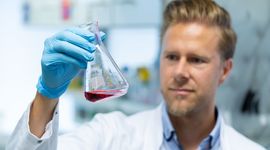Study suggests injection of gene-corrected skin cells to be a safe and promising approach for RDEB
New scientific publication with EB House contribution
A recent international phase I study has confirmed the safety and potential efficacy of an ex vivo gene therapy being tested for the first time in RDEB patients. The results were published in the scientific journal JCI insight.
The severe forms of RDEB are caused by mutations in the collagen 7 gene, leading to lack of the collagen 7 protein. As a result, no anchoring fibrils can be formed, which serve to maintain cohesion of the skin layers. Their absence leads to severe blistering in RDEB skin.
Despite worldwide research efforts, there is still no efficient and causal treatment for RDEB patients. Currently, the most promising approach is an ex vivo gene therapy, where skin cells are taken from patients in order to correct them by introducing a healthy copy of the collagen 7 gene using a viral vector (= modified virus particles, that can not infect the body). The corrected cells are then brought back into the skin where they ensure the production of anchoring fibrils to attach the skin layers.
In this study, the safety of an ex vivo gene therapy was investigated in 4 adult RDEB patients, using a particularly safe viral vector to correct the patients’ own subcutaneous cells (fibroblasts). Fibroblasts were confirmed to produce a healthy collagen 7 protein prior to retransfer into the patients’ skin. Each subject received 3 intradermal injections of 1 million corrected fibroblasts each and were then followed up for a period of 12 months to assess the safety and also the efficacy of the approach.
None of the patients experienced serious adverse events due to the treatment. Furthermore, no autoimmune reaction against the newly introduced healthy collagen 7 protein was observed, thus confirming the safety of this therapy.
In terms of efficacy, in two out of four subjects, a significant increase in the amount of collagen 7 was observed in the injected skin compared to untreated skin, lasting up to 12 months.
These results have laid the ground for subsequent studies to further explore the efficacy of this first-in RDEB patients applied therapy.
To access the article please click here
